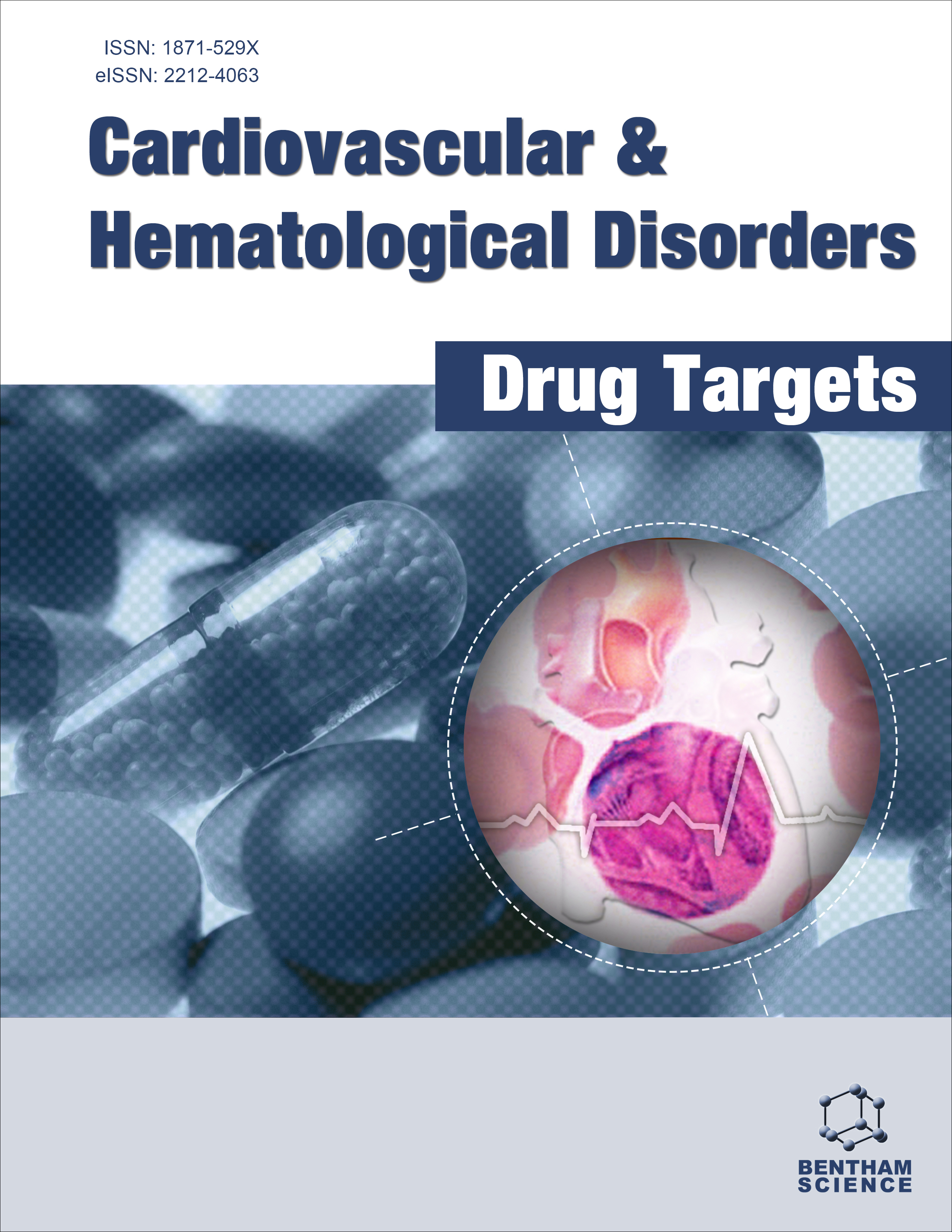- Home
- A-Z Publications
- Cardiovascular & Haematological Disorders - Drug Targets
- Previous Issues
- Volume 10, Issue 2, 2010
Cardiovascular & Haematological Disorders - Drug Targets - Volume 10, Issue 2, 2010
Volume 10, Issue 2, 2010
-
-
Editorial [Hot topic:Thromboembolism in Patients with Malignancy (Guest Editor: Ioannis Starakis)]
More LessIt is well known that malignancy is often associated with a hypercoagulable state. Malignant cells may express procoagulant activity, such as cancer procoagulant and tissue factor, which can unswervingly trigger thrombin production. Additionally, normal host cells (monocytes, platelets, and endothelial cells) may also express or release procoagulants in response to the tumour. Cell adhesion moiety p-selectin, is an important Read More
-
-
-
Nonbacterial Thrombotic Endocarditis (Marantic Endocarditis) in Cancer Patients
More LessAuthors: Elias E. Mazokopakis, Periklis K. Syros and Ioannis K. StarakisThe term nonbacterial thrombotic endocarditis (NBTE), or marantic endocarditis, refers to a spectrum of lesions ranging from microscopic aggregates of platelets to large vegetations on previously undamaged heart valves (most often aortic and mitral) in the absence of a bloodstream bacterial infection. NBTE is a rare condition often associated with hypercoagulable states or advanced malignancy such as adenocarcino Read More
-
-
-
Thrombotic Microangiopathy and Occult Neoplasia
More LessAuthors: Maria Teresa Pirrotta and Alessandro BucalossiThrombotic thrombocytopenic purpura (TTP), which is typically characterized by fever and central nervous system manifestations and hemolytic uremic syndrome (HUS), in which renal failure is a prominent feature are the most common thrombotic microangiopathies (TMAs). TTP is usually associated with a severe deficiency of ADAMTS13 [a metalloproteinase involved in the degradation of von Willebrand factor (vWF) multi Read More
-
-
-
Drug-Induced Thromboembolic Events in Patients with Malignancy
More LessAuthors: Ioannis Starakis, Angelos Koutras and Elias E. MazokopakisPatients with malignancies are often in a hypercoagulable status. The pathogenetic mechanisms of thrombotic events in malignancy are multifaceted and consist of release or expression of procoagulants by cancer cells, but also appearance of procoagulant action by normal host cells. Most importantly, current therapeutic modalities for cancer such as high dose chemotherapy and surgery represent a significant a Read More
-
-
-
Paradoxical Thrombotic Effects of Aspirin: Experimental Study on 1000 Animals
More LessAuthors: Christian Doutremepuich, Omar Aguejouf, Vanessa Desplat and Francisco X. EizayagaAspirin administration decreases the risk of vascular ischemic problems. However, aspirin withdrawal may temporarily increase this risk. Previous studies reported that high dilutions of aspirin might cause a pro-thrombotic effect. This paper studies the effect of the lower end of the aspirin dose-response curve, its possible mechanism and clinical implications. Protocol: Wistar rats were distributed into 100 groups of 10 rats each. Read More
-
-
-
A Stress Repair Mechanism That Maintains Vertebrate Structure During Stress
More LessBased on Capillary Gate Theory and Tissue Repair Theory, this paper describes the “Stress Repair Mechanism” (SRM) that maintains and repairs vertebrate tissues. It accounts for most of the mysterious manifestations of allostasis that remain unexplained by Hypothalamic-Pituitary-Axis (HPA) hormones and thereby enables the Universal Theory of Medicine predicted by Hans Selye. SRM activity explains hemodynamic physiolog Read More
-
-
-
Evaluation of Vancoplus Versus Ceftriaxone Against Cephalosporin Resistance MRSA Strain in Experimental Meningitis Model
More LessAuthors: A. Soni, M. Chaudhary, V. K. Dwivedi, S. Kumar and S. M. ShrivastavaThe aim of this study was to compare the efficacy of ceftriaxone plus vancomycin (Vancoplus) versus ceftriaxone alone against cephalosporin resistant methicillin-resistant Staphylococcus aureus (MRSA) strain by using meningitis mice model. The MRSA strain ATCC 43300 was used to induce meningitis in mice. The mice were fed standard pelleted diet and water ad libitum. The test room was air conditioned with tempe Read More
-
-
-
Discussion on Pharmacogenetic Interaction in G6PD Deficiency and Methods to Identify Potential Hemolytic Drugs
More LessAuthors: Genesia Manganelli, Annalisa Fico, Giuseppe Martini and Stefania FilosaGlucose-6-phosphate dehydrogenase (G6PD) deficiency is the most common form of red blood cell enzymopathy. The disorder has reached polymorphic frequencies in different parts of the world due to the relative protection conferred against malaria. G6PD is a housekeeping X-linked gene encoding the first enzyme of the pentose phosphate pathway, an NADPH-producing dehydrogenase. Because erythrocytes do not Read More
-
-
-
Diabetes, Hyperglycemia and Accelerated Atherosclerosis: Evidence Supporting a Role for Endoplasmic Reticulum (ER) Stress Signaling
More LessAuthors: Cameron S. McAlpine, Anna J. Bowes and Geoff H.WerstuckDiabetes mellitus is associated with both micro- and macrovascular complications that can lead to significantly elevated incidence of retinopathy, nephropathy, neuropathy, myocardial infarction and stroke. The diabetic cardiovascular mortality rate exceeds 70% and individuals with diabetes are 2-3 times more likely to die from myocardial infarction and stroke than those with no history of diabetes even after controlling for ot Read More
-
Volumes & issues
-
Volume 24 (2024)
-
Volume 23 (2023)
-
Volume 22 (2022)
-
Volume 21 (2021)
-
Volume 20 (2020)
-
Volume 19 (2019)
-
Volume 18 (2018)
-
Volume 17 (2017)
-
Volume 16 (2016)
-
Volume 15 (2015)
-
Volume 14 (2014)
-
Volume 13 (2013)
-
Volume 12 (2012)
-
Volume 11 (2011)
-
Volume 10 (2010)
-
Volume 9 (2009)
-
Volume 8 (2008)
-
Volume 7 (2007)
-
Volume 6 (2006)
Most Read This Month
Article
content/journals/chddt
Journal
10
5
false
en


